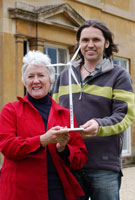Menu

Women and environment
A Dozen "Must Have" Plants for Backyard Habitat
Karen Williams of the New Jersey Audubon Society presents ways to make your garden a sanctuary, feeding ground and home for butterflies, birds and helpful insects:
Creating a wildlife garden is something many people interested in nature have embraced. It is an easy, positive step that increases (even if only by one small lot) the space available for wildlife. As we watch more and more of nature fall to the strip mall, each small addition to available food and shelter takes on greater importance...
Community Gardens in New York City
Dr. Elisabeth Meyer-Renschhausen, a member of our WLOE e.V. German association's executive board and an expert on local initiatives, including community gardens, gave a presentation at the American Community Gardening Association Conference in Los Angeles, August 13-15, 2006.
"The growing importance of community gardens in New York City is based on their social diversity. In many gardens the production of food also plays an increasing role. In other gardens the community aspect, the action within the community is at the forefront. Most gardens are however oriented towards making an active contribution to the beauty and sustainability of the environment."
Green building in Brooklyn
Susan Boyle and her husband Benton Brown turned an abandoned warehouse into a model of sustainable construction. With its planted roof, solar panels, and lots of recycled materials, this project is easy on the environment -- and the eyes. Find out how they did it:
Lofty Ambitions by Amanda Griscom, 25 June 2004, Grist Magazine
Susan Boyle: "We want people to see, intuit, and understand the difference of a building like this," she said. "The higher goal here is simply to motivate more people to want to live in this kind of environment and take on similar steps or projects," she said. "We're basically in the middle of an industrial sector. There's not a whole lot in the way of parks or trees. So when people ride by on the elevated train and see one rooftop covered with vegetation and another covered with solar, it creates questions in their minds."
Some resources and sources on information on women and environment:
WEDO Primer: Women and Sustainable Development
Local Agenda, May 2001
Section III Mobilizing Women's Involvement
"Two strategies for overcoming the barriers to women's participation in local governance, based on WEDO's consultations with women leaders, NGOs and community representatives..." See full report at:
http://www.wedo.org/sus_dev/section3.htm
Selected Sources-Women, Environment and Development
compiled by Marlene Roy, International Institute for Sustainable Development, Winnipeg, Manitoba.

The Women's Institute powers up with green Ecotricity (UK)
15th April 2003 - "The National Federation of Women's Institutes (NFWI) is making a stand against the increasing threat of climate change by joining up with Ecotricity, the world's first green electricity company. With the environment high on the NFWI's agenda and climate change and sustainable development a real concern amongst its 230,000 members, this powerful partnership aims to help clean up the UK's electricity production..."
http://www.ecotricity.co.uk/code/popup_pr_WIapr03.html

The internet "Grist Magazine: gloom and doom with a sense of humor" features an environmental column by Umbra Fisk. Besides the general questions she answers, there is an archive on recycling. Here's a Q&A from that:
The question, from a reader wondering about the information on his box of crackers: What is "pre-consumer" content? I mean, if the label is true ("carton made from 100 percent recycled paperboard -- minimum 35 percent post-consumer content"), what is the other 65 percent? And what is paperboard?
Umbra's answer:
"Pre-consumer content is the stuff picked up from the cutting-room floor and recycled into new paper products. Paper that was wrinkled, or the odds and ends of a sheet after the pattern was cut out for the cereal box, or the fuzzy sides of a poured sheet, the "deckle" -- anything left over after the first go-round. The 35 percent post-consumer content is just what it says -- 35 percent of the material that went into your paperboard had already been through consumer hands, while the other 65 percent consists of factory leftovers being given a new shot to make it out into the consumer world. The box-maker may rely on government contracts that mandate a specific percentage of recycled content. Paperboard is paper more than 0.3 millimeters thick." See this and more at:
http://www.gristmagazine.com/ask/ask032504.asp

